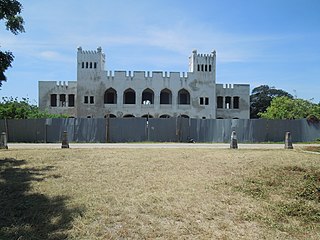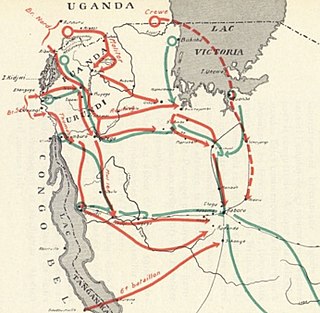Related Research Articles

The Royal Naval Air Service (RNAS) was the air arm of the Royal Navy, under the direction of the Admiralty's Air Department, and existed formally from 1 July 1914 to 1 April 1918, when it was merged with the British Army's Royal Flying Corps to form the Royal Air Force (RAF), the world's first independent air force.

Tanga is both the name of the most northerly port city of Tanzania on the west of the Indian Ocean, and the capital of Tanga Region. It had a population of 273,332 in 2012. The name Tanga means "sail."

Bagamoyo, is a coastal town founded at the end of the 18th century, though it is an extension of a much older Swahili settlement, Kaole. It was chosen as the capital of German East Africa by the German colonial administration and it became one of the most important trading ports for the Germans along the East African coast along the west of the Indian Ocean in the late 19th and early 20th century. Today, it is the capital of the Bagamoyo District in Pwani Region. In 2011, the town had 82,578 inhabitants.

HMS Manica was a merchant steamship that was built in England in 1901 and was scrapped in Japan in 1931. She was built as a dry cargo ship but spent the latter part of her career as an oil tanker.

HMS Hyacinth was one of three Highflyer-class protected cruisers built for the Royal Navy in the 1890s. Initially assigned to the Channel Fleet, she spent much of her early career as flagship for the East Indies Station. She was reduced to reserve in 1912 after a lengthy refit before becoming the flagship of the Cape of Good Hope Station in 1913. After the beginning of World War I in August 1914, she spent the first few months of the war escorting convoys around South Africa. In early 1915, she was deployed to German East Africa to blockade the German light cruiser SMS Königsberg. She destroyed a German blockade runner attempting to bring supplies through the blockade in April and sank a German merchant vessel in early 1916. Hyacinth remained on the Cape Station for the rest of the war and was paid off in 1919, although she was not sold for scrap until 1923.

MV Liemba, formerly Graf Goetzen or Graf von Goetzen, is a passenger and cargo ferry that runs along the eastern shore of Lake Tanganyika. The Marine Services Company Limited of Tanzania sails her, with numerous stops to pick up and set down passengers, between the ports of Kigoma, Tanzania and Mpulungu, Zambia.

The East African campaign in World War I was a series of battles and guerrilla actions, which started in German East Africa (GEA) and spread to portions of Portuguese Mozambique, Northern Rhodesia, British East Africa, the Uganda Protectorate, and the Belgian Congo. The campaign all but ended in German East Africa in November 1917 when the Germans entered Portuguese Mozambique and continued the campaign living off Portuguese supplies.

Admiral of the Fleet Rosslyn Erskine Wemyss, 1st Baron Wester Wemyss,, known as Sir Rosslyn Wemyss between 1916 and 1919, was a Royal Navy officer. During the First World War he served as commander of the 12th Cruiser Squadron and then as Governor of Moudros before leading the British landings at Cape Helles and at Suvla Bay during the Gallipoli campaign. He went on to be Commander of the East Indies & Egyptian Squadron in January 1916 and then First Sea Lord in December 1917, in which role he encouraged Admiral Roger Keyes, Commander of the Dover Patrol, to undertake more vigorous operations in the Channel, ultimately leading to the launch of the Zeebrugge Raid in April 1918.

Manza Bay is a bay in Tanzania. It is on the coast, some 10 miles (16 km) north of the town of Tanga.

HMS Talbot was an Eclipse-class protected cruiser built for the Royal Navy in the mid-1890s.

Pangani Town is a historic Swahili settlement located on the south eastern shore of Tanga Region, Tanzania. The town lies 45 km (28 mi) south of the city of Tanga, at the mouth of the Pangani River. It is the headquarters of the Pangani District. Administrately the town Pangani is situated within two wards, Pangani Mashariki and Pangani Magharibi. The town is currently the largest settlement in Pangani district and is a major tourist attraction in Tanga region.

HMS Wrestler (D35) was a V and W-class destroyer built by the Royal Navy during the First World War and active from 1939 to 1944 during the Second World War. She was the first Royal Navy ship to bear that name, and the only one to do so to date.
HMS Helmuth was a German tug that the Royal Navy captured at the beginning of World War I and armed as a picket boat. She served in the East African campaign including the battles of Zanzibar and Tanga, she survived a German attack at Dar es Salaam, and took part in blockading SMS Königsberg in the Rujifi Delta. In 1916 she took part in an amphibious assault on the coastal town of Bagamoyo.
HMS Labuan (K584), ex-Gold Coast, was a Colony-class frigate of the United Kingdom which served in the Royal Navy during World War II. She was originally ordered by the United States Navy as the Tacoma-class patrol frigateUSS Harvey (PF-80) and briefly renamed Gold Coast before she was transferred to the Royal Navy prior to completion.

HMS Vesper was a V-class destroyer of the British Royal Navy that saw service in World War I and World War II.

The second HMS Vanity was a V-class destroyer of the British Royal Navy that saw service in World War I and World War II.

HMS Versatile (D32) was an Admiralty V-class destroyer of the British Royal Navy that saw service in World War I, the Russian Civil War, and World War II.

HMS Viscount was a V-class destroyer of the British Royal Navy that saw service in the final months of World War I and in World War II.

The Tabora Offensive was an Anglo-Belgian offensive into German East Africa, which ended with the Battle of Tabora in the north-west of German East Africa, it was part of the East African Campaign in World War I. The forces of the Belgian Congo crossed the border with German East Africa and captured the port city of Kigoma and the city of Tabora. In August a smaller Lake Force under the command of the South African brigadier general Crewe, launched a parallel attack from Uganda, also aimed at taking Tabora. The completion of the Tabora Offensive not only left much of the Ruanda-Urundi territory under Belgian military occupation but gave the Allies control of the important Tanganjikabahn railway.

The Royal Navy was active in East African waters from the 1850s to the 1960s.
References
- ↑ "HMS Manica – February to December 1916, UK out, German East Africa Campaign". Royal Navy Log Books of the World War 1 Era. Naval-History.net. Retrieved 9 January 2022.
- ↑ Cato, Conrad (1919). The Navy Everywhere. Constable: London.[ page needed ]
Coordinates: 06°03′00″S38°47′00″E / 6.05000°S 38.78333°E